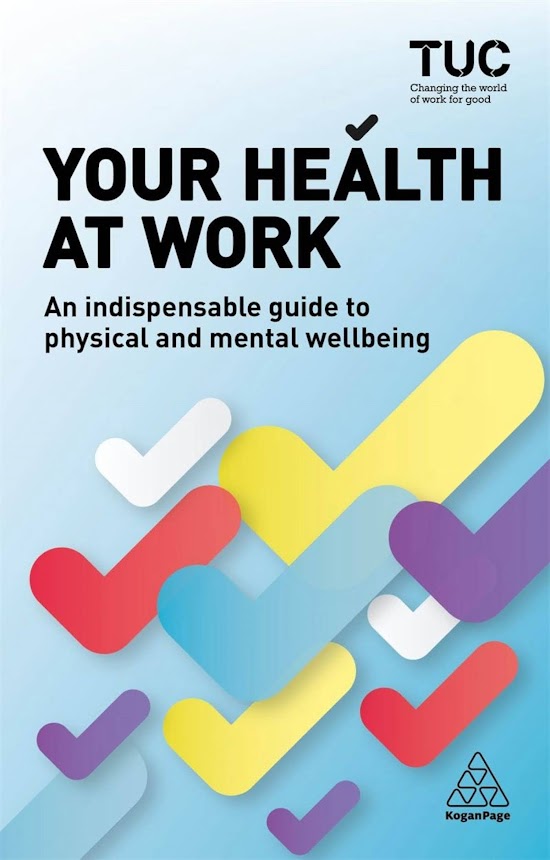According to a recent study by The Conference Board regarding the workforce, 34% of participants noted a decrease in their mental well-being in the past six months, with 37% sensing a diminished sense of inclusion. Nearly half of these individuals linked their sentiments to issues arising in the work environment.
Keeping this in consideration, the condensed version of the book titled Your Wellness at Work, written by Becky Allen and Howard Fidderman on behalf of the Trades Union Congress (TUC), delivers a thorough examination of potential dangers in the workplace and chronic illnesses, with a specific focus on mental and physical health problems that are either spawned or exacerbated by work-related factors.
- Suggestion
- Key-Points
- Mental health stands as a crucial workplace matter
- Workplace intimidators present health risks
- Cancer emerges as a workplace hazard
- Millions are affected by back problems and repetitive strain ailments
- Workers with disabilities are entitled to workplace protections
- The workforce is aging and contending with chronic health issues
- About the Author
- Evaluation
Suggestion
If concerns about health hazards at the workplace trouble you, this book is a must-read. Authors Becky Allen and Howard Fidderman, representing the Trades Union Congress (TUC), present an in-depth review of workplace risks and long-term illnesses, addressing mental health issues and medical conditions that are either originated or intensified by work conditions. While the primary focus is on the United Kingdom, and even though this was written before the COVID-19 outbreak, they offer remedies and suggestions for employers and employees globally.

Key-Points
- Mental health stands as a crucial workplace matter.
- Workplace intimidators present health hazards.
- Cancer poses a threat in the workplace.
- Injuries to the back and repetitive stress ailments impact millions.
- Employees with disabilities possess workplace entitlements.
- The professional populace is getting older and confronting persistent health issues.
Mental health stands as a crucial workplace matter
In the year 2017, a self-governing appraisal panel issued critical conclusions regarding mental health within the work environment. Every year, mental illnesses cost the United Kingdom’s economy £74 billion to £99 billion (approximately $92 billion to $123 billion), with companies bearing £33 billion to £42 billion of those expenses.
About 17% of grown-ups — one out of six individuals — endure a mental health disorder, as disclosed by the UK Department of Health. These issues encompass depression, suicidal thoughts, bipolar conditions, eating and sleep disorders, solitude, stress, anxiety episodes, and obsessive-compulsive disorders.
“For administrative bodies and entities overseeing occupational health and safety…the focus had traditionally been on…physical health.”
Three decades prior, a majority of employees grappling with mental health conditions scarcely had any prospects of receiving aid at the workplace. In the contemporary professional setting, health and safety agendas incorporate mental health well-being initiatives and suicide prevention strategies. Labor unions, mental health proponents, and healthcare professionals have spearheaded efforts to acknowledge the correlations between work settings and mental health.
The 2017 appraisal panel outlined specific mental health benchmarks for workplaces. The panel advocated that employers should:
- Formulate strategic schemes to bolster employees’ mental well-being. Employers should furnish details to employees during recruitment proceedings and at regular intervals throughout their tenure.
- Propagate awareness about mental health within the workforce.
- Foster a healthy equilibrium between work and personal life.
- Create opportunities for routine dialogues between employees and superiors.
Most individuals are hesitant to acknowledge mental health concerns or associated conditions. Employees might dread humiliation and bias. However, rapid intervention when signs surface enhances outcomes and expedites employee recuperation.
“[Employees can] fortify their mental health by analyzing stress sources and poor mental health causes, and by personally initiating practical measures to mitigate these triggers.”
The subsequent measures offer invaluable assistance to individuals tackling mental health crises:
- Consult your primary healthcare provider. Your physician might refer you to a mental health specialist.
- Seek support from workplace allies: colleagues, supervisors, or union representatives.
- Delve into regulations and HR guidelines for insights on safeguards, accommodations, and additional perks.
Protect your well-being by adopting preventive measures to alleviate stress and emotional strain. These actions encompass managing your schedule and setting clear boundaries between personal and professional responsibilities. Plan regular breaks during the day and utilize your allotted leave days. Other preventive tactics include:
- Maintain a consistent workout regimen – This aids in reducing stress, anxiety, and depression.
- Identify your stress triggers – Keep track of and acknowledge conflicts, demands, and circumstances that jeopardize your mental welfare.
- Be present in the moment – Practicing mindfulness can deter depression.
- Pursue hobbies and cultivate connections – Active involvement in hobbies, clubs, and communal events fosters and preserves mental health and general well-being.
- Establish a support system, either at work or home – This is particularly crucial when you are caring for a relative, friend, or child. Explore mental health resources in your vicinity or workplace, including Employee Assistance Programs (EAPs). Share your concerns and stress triggers with a companion or life partner.
Workplace intimidators present health risks
Harassment stemming from bullying might encompass abusive conduct or language utilized by the bully with the intent to humiliate, harm, undermine, or demoralize another individual. This misconduct can also manifest in cyberbullying, which involves abusive conduct via email, social media, and other digital platforms.
“Compared to conventional workplace bullying, evidence [of cyberbullying] could be easier to document and trace back to the perpetrator.”
The UK Health and Safety Executive (HSE) discovered that workplace bullies typically outrank their targets. A government study divulged that managers were responsible for nearly three-quarters of all instances of harassment or bullying. Roughly 30% of employees disclosed experiences of bullying during work hours, with 36% opting to leave jobs following bullying episodes. Harassment correlates with specific health issues and hazards, including migraines, headaches, nausea, vomiting, sleep disorders, PTSD, suicidal thoughts, panic attacks, and substance abuse including alcohol, tobacco, and other substances.
Official personnel and workplace specialists suggest that victims of bullying or harassment can tackle the situation by taking these measures:
- Maintain a log detailing dates, times, locations, and other particulars documenting the harassment.
- Share your encounters with a companion or trustworthy co-worker.
- Consult with a union representative or labor official.
- Reach out to a support helpline, a governmental bureau, or health professionals.
- Arrange a meeting with your company’s HR leaders.
Cancer emerges as a workplace hazard
Globally, around 666,000 individuals succumb to workplace-related cancers annually. In the United Kingdom, occupational cancers claim the lives of 8,000 workers each year. The catalog of carcinogenic elements in the workplace includes diesel exhaust, asbestos, and silica dust.
Female employeesIndividuals who are on the night schedule face heightened chances of developing skin, breast, and gastrointestinal cancers. Consistent night shifts contribute to a range of health issues for both males and females, such as elevated stress levels, cardiac problems, digestive complications, hypertension, and an increased likelihood of accidents.
“In addition to regulating exposure, employers are legally obligated to conduct suitable health monitoring of workers exposed to specific substances.”
Employers are legally required to safeguard the well-being of employees while on duty. According to the Health and Safety at Work Regulations (1999) in the United Kingdom, employers must conduct workplace health assessments, which include appraisals of the potential cancer risks in the workplace. The regulations mandate that employers regularly monitor the health of workers whose roles expose them to various chemicals. Workers with certain cancers connected to occupational hazards may be eligible for benefits and recompense.
Millions are affected by back problems and repetitive strain ailments
Clinically speaking, sore backs, neck discomfort, and repetitive strain injuries fall under musculoskeletal disorders (MSDs), a group that also encompasses painful muscle and joint injuries. These issues affect millions of employees globally and 17% of the populace in England. In the UK, workplace-related disorders in this category are major contributors to poor occupational health:
- Approximately 500,000 workers in the UK experienced back pain or repetitive strain injuries tied to the workplace in 2016 and 2017.
- MSDs led to nearly 31 million combined sick days for employees in 2016.
- Back, joint, and muscle injuries accounted for two out of every 10 sick days. Only sick days taken by employees due to minor illnesses like coughs and colds surpassed this rate in 2016.
The European Trade Union Confederation has labeled back, muscle, and joint injuries as an epidemic. In conjunction with this declaration, the labor union has also urged the European Union to take more robust action on the musculoskeletal injuries that compromise the quality of life for numerous workers.
Unfortunately, the workplace presents numerous scenarios, conditions, and situations where individuals can injure their backs, legs, necks, joints, and arms. For instance, handling and hoisting heavy objects can result in injuries or worsen existing ones. Repetitive motions or poorly designed computer setups contribute to strain injuries. Few industries remain untouched by this expansive category of workplace harm, which can afflict employees on farms and construction sites, as well as in hospitals and traditional offices.
“Receiving appropriate treatment and support early on when you are off work for an extended period can significantly aid in a successful return to work.”
Prevention plays a critical role in mitigating current injuries or avoiding severe harm in the workplace. Employers have a legal duty to endorse and furnish a safe working environment. A union of corporate leaders, employees, and medical professionals can create optimal procedures, risk assessment tools, and educational programs to prevent workplace injuries.
It is the responsibility of employees to engage in self-care while at work. For this reason, taking regular breaks throughout the workday is essential. During these breaks, stand up, stretch, and move around. Measures for preventing injuries include:
- Avoiding alcohol, tobacco, and excessive weight gain.
- Maintaining an active lifestyle and setting a weekly target of 150 minutes of physical activity.
- Ensuring adequate exposure to sunlight and vitamin D.
- Prioritizing mental well-being.
- Discuss with supervisors or union representatives about tasks or work duties that cause physical discomfort.
Workers with disabilities are entitled to workplace protections
In 2017, the UK devised and released a new strategy to enhance workplace opportunities and safeguards for employees with disabilities. This initiative followed the enactment of the Equality Act of 2010, which granted protection against discrimination to individuals with disabilities.
The group of individuals covered includes those with mental or physical disabilities, cancer, or an HIV diagnosis. The act also protects employees with certain persistent health conditions like migraines and epilepsy. The Equality Act lays out six scenarios outlining the types of bias that disabled workers sometimes encounter:
- Direct discrimination – This form of discrimination occurs when disabled employees receive inferior treatment compared to non-disabled workers in similar work circumstances.
- Indirect discrimination – Refers to policies and procedures that disproportionately affect disabled workers as opposed to their non-disabled colleagues.
- Lack of accommodations – Employers must provide “reasonable” adjustments to aid disabled employees in the workplace.
- Disability-related bias – This discrimination arises when an employee is treated unfairly due to accommodations or other factors, such as requests for medical time off, directly connected to a disability.
- Bullying or harassment – This type of discrimination materializes as mistreatment, humiliation, or degradation.
- Victimization – This type of discrimination often manifests as retaliation against individuals who have submitted complaints.
The workforce is aging and contending with chronic health issues
An aging workforce stands out as one of the primary trends in both public health and the professional sphere. In 2018, the count of employees aged over 50 surpassed 10 million in the UK for the first time. These figures indicate that in 2018, 33% of the UK workforce was over 50 years old, as opposed to just 20% in the early 1990s. Furthermore, life expectancy has risen as birth rates have declined. Given these trends, health specialists posit that workplaces need to become more inclusive of aging staff.
The knowledge and expertise of older workers are invaluable to employers. Consequently, numerous unfavorable stereotypes regarding aging, health, and employability persist in professional environments. For instance, one misconception implies that older employees are more prone to calling in sick. In reality, older workers do not take more sick days than their younger counterparts. Medical and labor experts propose various measures for firms aiming to accommodate and integrate older employees:
- Implement flexible schedules, offering part-time options and remote work arrangements.
- Assess the workplace environment for potential risks to older workers.
- Ensure equal access to training and education.
Chronic illnesses are prevalent, with many employees grappling with conditions such as diabetes, migraines, heart disease, epilepsy, persistent pain, brain injuries, and other ailments. The support provided by your employer can aid in managing a chronic condition while at work.
About the Author
The Trades Union Congress (TUC) is a union federation comprising 50 labor unions in the United Kingdom, representing around 5.6 million members. Becky Allen and Howard Fidderman work as freelance authors.
Evaluation
The manual is a pragmatic handbook aimed at helping individuals enhance their physical and psychological welfare in the workplace. It is penned by a pair of independent authors who have collaborated with the Trades Union Congress (TUC), the UK’s largest amalgamation of labor unions, to furnish solid and pertinent insights and counsel. The book comprises of four sections:
- Part I: Your Wellbeing in the Workplace. This section introduces the notion of workplace wellness, elucidating why employees and employers must advocate for a safe and healthful work setting. It also delineates the legal rights and obligations of employees and employers concerning wellness and security matters and offers beneficial resources and connections for additional assistance.
- Part II: Your Physical Welfare in the Workplace. This section discusses prevalent physical health hazards in the workplace, like discomforts and sprains, dangerous substances, mishaps, noise, tremors, temperature, illumination, and radiation. It expounds upon how these hazards can impact the well-being of employees and suggest preventative or mitigative actions. It likewise provides suggestions and drills to aid individuals in enhancing their stance, fitness, nourishment, hydration, rest, and sanitation.
- Part III: Your Mental Welfare in the Workplace. This segment addresses common psychological health hazards at work, such as strain, uneasiness, despondency, bullying, harassment, bias, aggression, and trauma. It delineates how these hazards can influence the mental wellness of employees, and offers coping strategies. It also dispenses guidance and activities to foster individuals to fortify their resilience, self-assurance, self-respect, communication skills, and connections.
- Part IV: Your Welfare Beyond the Workplace. This section assists individuals in putting into practice the teachings garnered from prior sections into their personal and vocational lives. It encompasses themes such as equilibrium between work and personal life, professional growth, retirement planning, volunteer work, and continuous learning. It also stimulates individuals to exchange their encounters and insights with others who could benefit from them.
The book stands as a comprehensive and beneficial tool for anyone seeking to ameliorate their well-being in the workplace or delving deeper into the subject. The authors are both seasoned wordsmiths who have delved extensively into the realm of workplace health. They articulate in a lucid, concise, and captivating manner that renders the book accessible and comprehensible. Moreover, they incorporate real-life instances, case learnings, data, and quotations from specialists and laborers to underscore their viewpoints and provide substantiation for their assertions.
The book not only imparts information but also inspires and empowers individuals. It suits anyone keen on refining their well-being in the workplace or gaining further insights on the subject. I strongly advocate it to individuals intrigued by this area.


